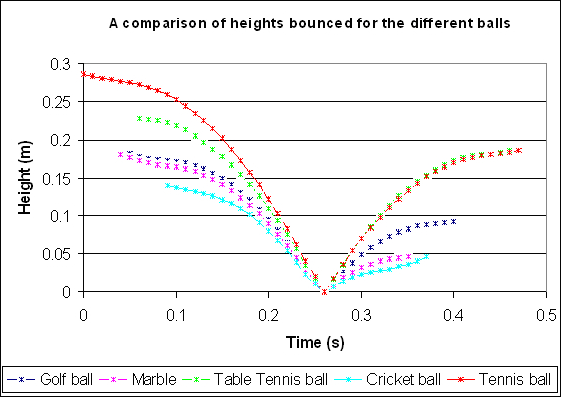Coefficient of Restitution
Claimed by Maria Moreno
The coefficient of restitution measures the amount of Kinetic Energy remains and how much energy is lost after a collision. It also shows the degree of elasticity of a collision. It is defined as the ratio of the difference in initial velocities divided by the difference in final velocities. The coefficient of restitution of a collision is usually between 0 and 1 except in rare cases when energy is released by a collision.

The Main Idea
The coefficient of restitution is a ratio that describes the degree of elasticity of a collision. It is used to solve problems dealing with collisions that are not perfectly elastic or inelastic. The equation that describes the coefficient of restitution involved dividing the difference in the final velocities by the difference in the initial velocity.
Consider objects A and B with initial velocities vAi and vBi and final velocities vAf and vBf. The coefficient of restitution, e is determined with the following formula:
[math]\displaystyle{ e = \frac{v_{Bf}-v_{Af}}{v_{Ai}-v_{Bi}} }[/math]
A Mathematical Model
Consider a perfectly elastic collision between objects A and B where vAi and vBi refer to the initial velocities of A and B and vAf and vBf refer to the final velocities of A and B.
Start with the conservation of momentum principle which states that
[math]\displaystyle{ \vec{p_i} = \vec{p_f} }[/math]
and
[math]\displaystyle{ m_A\vec{v_{Ai}}+m_A\vec{v_{Bi}}=m_A\vec{v_{Af}}+m_A\vec{v_{Bf}} }[/math] (1)
Remember that for a perfectly elastic collision kinetic energy is also conserved meaning:
[math]\displaystyle{ KE_i = KE_f }[/math]
and
[math]\displaystyle{ \frac{1}{2}m_A v^2_{Ai}+\frac{1}{2}m_A v^2_Bi=\frac{1}{2}m_A v^2_{Af}+\frac{1}{2}m_A v^2_{Bf} }[/math] (2)
Dividing (2) by (1) yields:
[math]\displaystyle{ \vec{v_{Ai}}+\vec{v_{Bi}}=\vec{v_{Af}}+\vec{v_{Bf}} }[/math]
[math]\displaystyle{ 1=\frac{v_{Ai}+v_{Bi}}{v_{Af}+v_{Bf}} }[/math]
[math]\displaystyle{ e=\frac{v_{Ai}+v_{Bi}}{v_{Af}+v_{Bf}} }[/math]
For perfectly elastic collision e=1.
Inelastic Collisions
An inelastic collision is a type of collision where Kinetic Energy is not conserved. In this case the difference in initial velocities will not equal the difference in final velocities. This means that the coefficient of restitution will not equal 1.
Consider the same collision as previously described, except this collision is inelastic and Kinetic Energy is not conserved. Since some of the kinetic energy is dissipated:
[math]\displaystyle{ \frac{1}{2}m_A v^2_{Ai}+\frac{1}{2}m_A v^2_Bi\lt \frac{1}{2}m_A v^2_{Af}+\frac{1}{2}m_A v^2_{Bf} }[/math]
[math]\displaystyle{ \frac{v_{Ai}+v_{Bi}}\lt {v_{Af}v_{Bf}} }[/math]
[math]\displaystyle{ e=\frac{v_{Ai}+v_{Bi}}{v_{Af}+v_{Bf}}\lt 1 }[/math]
Perfectly Elastic Collision
A Computational Model
Examples
Be sure to show all steps in your solution and include diagrams whenever possible
Simple
Middling
Difficult
Bouncing Ball Example:
Connectedness
How is this topic connected to something that you are interested in?
How is it connected to your major (Mechanical Engineering)?
The coefficient of restitution is a key concept in the study of Dynamics which is the foundation of many aspects of mechanical engineering.
Is there an interesting industrial application? In sports the coefficient of restitution is an important concept especially in sports like golf or tennis where collisions are a frequent and essential part of the game. In these sports sometimes limitations are put on how high the coefficient of restitution can be for certain clubs or bats. The maximum coefficient of restitution allowed in golf for clubs is .82. There have been studies done on the coefficients for different sports balls.
See also
Are there related topics or categories in this wiki resource for the curious reader to explore? How does this topic fit into that context?
Further reading
Books, Articles or other print media on this topic
External links
References
This section contains the the references you used while writing this page


